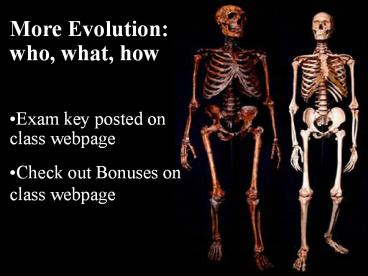More Evolution: who, what, how - PowerPoint PPT Presentation
Title:
More Evolution: who, what, how
Description:
More Evolution: who, what, how Exam key posted on class webpage Check out Bonuses on class webpage Natural Selection: Individuals that are most successful at ... – PowerPoint PPT presentation
Number of Views:141
Avg rating:3.0/5.0
Title: More Evolution: who, what, how
1
- More Evolutionwho, what, how
- Exam key posted on class webpage
- Check out Bonuses on class webpage
2
Evolution A species genetic component changes
as the individuals reproduce. These changes are
based on how the DNA changes and who reproduces.
3
Reproductive success evolutionary success
4
Evolution can occur via several processes. One
common process isNatural Selection Individuals
that are most successful at reproducing will pass
on more of their genetic information.
5
Natural Selection can only occur when both of
these conditions are met
- Genetic diversity gives rise to individuals with
different traits - and
- Not all individuals can reproduce equally
6
Evolution A species genetic component changes
as the individuals reproduce. These changes are
based on how the DNA changes and who reproduces.
7
Individuals are selected
But species evolve via changes in DNA during
reproduction.
8
Fig 24.6
Who evolves?Species.
A. leucurus
A. harrisi
- A population that can produce fertile offspring
- A population that does reproduce
- A population sharing genetic information
9
X
Horse
Donkey
Mule
10
X
Horse
Donkey
Sohorses and donkeys are not the same species.
Mule (sterile)
11
Fig 24.6
Who evolves?Species.
A. leucurus
A. harrisi
- A population that can produce fertile offspring
- A population that does reproduce
- A population sharing genetic information
12
Fig 22.19
How does evolution occur?
13
Fig 22.19
Divergent Evolution
14
Fig 22.20
Convergent Evolution
15
Evolution has no goal...no ultimate life form
wrong right
16
Natural Selection
- Individuals that are most successful at
reproducing will pass on more of their genetic
information.
17
Environmental changes drive evolution.
18
250 mya
180 mya
Fig 25.13
Plate Tectonics
65 mya
135 mya
current
19
The environment is in constant flux
20
Fig 24.5
Changing environment can separate populations and
lead to new species
21
Fig 24.9
Separation does not need to be geographic
Flies raised in different environments prefer to
mate with individuals from the same environment...
22
Flies raised in different environments prefer to
mate with individuals from the same environment...
Fig 24.9
23
Three basic types of selection
- Directional
- Stabilizing
- Disruptive
24
- Next even more EvolutionTypes of Selection and
Randomness - Exam key posted on class webpage
- Check out Bonuses on class webpage































